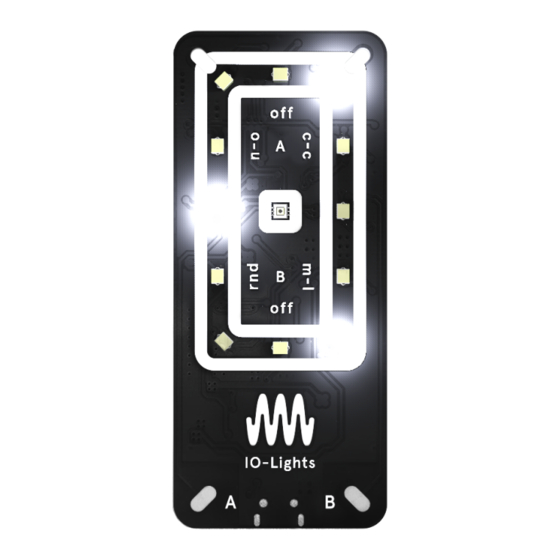
Summary of Contents for Instruments of Things IO-Lights
- Page 1 IO-Lights Light-Sensitive MIDI Controller User Manual Rev. B - March 2021 (Firmware version 1.1) ...
- Page 2 Index Safety Instructions What’s included About IO-Lights Getting Started Light Sensor LEDs Touch Buttons Random LED Mode Feedback Loop Mode Clock Synchronization Web App (Configuration) Firmware Update Change Log ...
-
Page 3: Safety Instructions
12 LEDs on the device. IO-Lights is used as a common MIDI controller. Just connect it via USB to the music software of your choice and start controlling sounds with light. You want to connect ... -
Page 4: Getting Started
Getting Started Light Sensor Based on the high-precision light sensor, IO-Lights generates and sends MIDI (Note or Control Change) messages to a USB-MIDI compatible host. The incoming brightness range can be either set manually or to automatically adapt to the environmental light. ... -
Page 5: Touch Buttons
LEDs The twelve, white LEDs on the UI of IO-Lights are intended to be used as a light source to influence the light sensor. The LEDs can be either controlled externally by incoming MIDI messages (m-l) or via a built-in LED mode (random or feedback loop). If ... - Page 6 In random (rnd) LED mode, the LEDs create random light patterns with a random number of LEDs turned on, making IO-Lights a visual, random MIDI source, which can be influenced by reflecting the LED light or an external light source. A time ...
-
Page 7: Clock Synchronization
Clock Synchronization IO-Lights can be synchronized to an external clock via MIDI to always play in time with your other instruments. Based on the external clock (and clock divider), IO-Lights sends the current measured brightness value in regular intervals as MIDI Note or ... - Page 8 Furthermore, new firmware images are automatically discovered from our server and can be flashed directly to IO-Lights in the web app via W ebUSB . At the moment of this writing, only Chrome/Chromium, Edge and Opera support both USB protocols. ...
- Page 9 Random Mode Level of If IO-Lights is not synchronized to an external clock, this Randomness parameter controls the time variation between two random LED states. The level of randomness parameter affects the average time and its variance. The higher the randomness, the lower the ...
- Page 10 Extras Clock Sync If enabled, IO-Lights will synchronize to an external MIDI clock and send the current brightness value in regular intervals. The synchronization becomes active (including start/stop) as soon as an external clock tick has been received. ...
-
Page 11: Firmware Update
( i nstrumentsofthings.com/io-app ) . The current firmware version of attached IO-Lights is shown at the bottom of the web app. If a new firmware is available on our website, the new version number is shown at the bottom. ... -
Page 12: Change Log
Firmware upgrades do not require any additional drivers for Mac OS and Linux. Unfortunately, the default Windows USB drivers do not support DFU though. To be able to upgrade IO-Lights firmware on Windows, we recommend the free tool Zadig (...

Need help?
Do you have a question about the IO-Lights and is the answer not in the manual?
Questions and answers